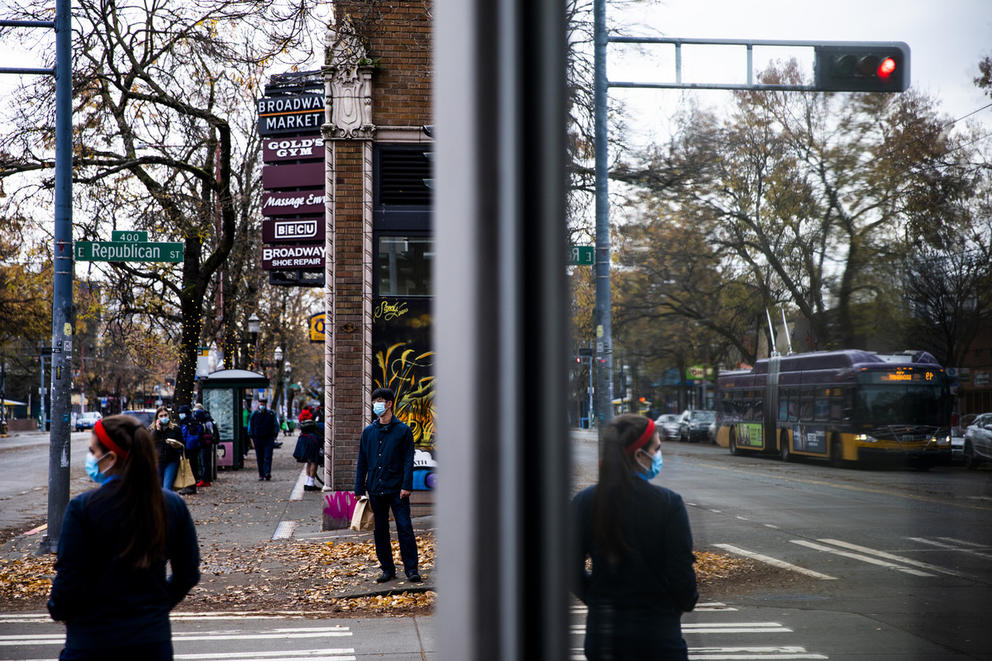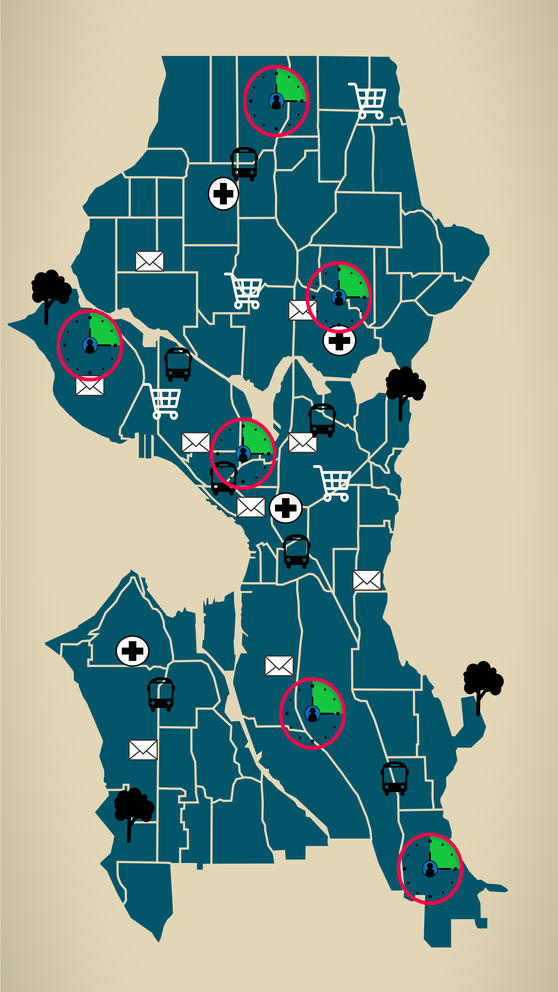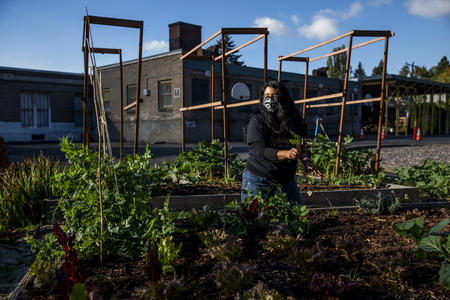In the so-called “15-minute city,” nutritious food, libraries, health care, parks, cafés and other amenities should be within a short walk, bike ride or roll from every resident’s homes, right in their own neighborhoods. Or, as Minneapolis planner Paul Mogush puts it bluntly: “Put the stuff closer together so it's easier to get to the stuff.”
This concept is catching on around the world as a strategy to bring cities and their economies back from the COVID-19 brink, while reducing car travel — and the accompanying pollution — to help meet climate goals.
In September, in a blog post titled “Seattle’s Plan to Build Back Better During COVID-19 Recovery,” the city’s Office of Planning and Community Development announced it would consider the 15-minute city concept as a potential guiding principle for the next version of the Comprehensive Plan, the city’s urban planning scripture that sets the guidelines for what the city will look, function and feel like in the future.
Translation: Seattle could become the next 15-minute city.
The new plan isn’t due until 2024, but in the meantime “we're already building the infrastructure for the 15-minute city — both because of the realities of the pandemic and because of the concrete steps we're taking,” says Seattle Mayor Jenny Durkan, who asked the Office of Planning and Community Development to look into the 15-minute city concept.
The massive shift to remote work will likely continue post-pandemic, Durkan says, and the city’s Stay Healthy streets program and expanded options for street dining could remain permanently.
“I think [the 15-minute city] could be one of the more positive and exciting things to come out of the COVID period,” Durkan says.
That’s basically the vision the mayors of the C40 Cities outlined in their “Agenda for a Green and Just Recovery” this summer. C40 Cities is a global coalition of cities focused on climate change (Seattle is a member; Durkan sits on its COVID-19 recovery task force).
“Overall, the crisis has exposed how ill-prepared human civilisation is to manage major global shocks,” the report notes. “The recovery should not be a return to ‘business as usual’ — because that is a world on track for 3°C or more of over-heating.”
Creating 15-minute cities could help cities recover economically and socially from the pandemic, and reach the emission-reduction goals from the Paris Agreement (which President-elect Joe Biden has pledged to rejoin). The tactics are many: adding more greenery to the city; reallocating roadways to pedestrians and cyclists; investing in public transit and rezoning parts of the city to allow more smaller scale offices, retail and hospitality as well as mixed-use buildings and a more diverse housing stock. With these solutions, the report notes, cities could minimize unnecessary travel and inject new life into neighborhood main streets, among other things.
That idea is not new; planners in cities like Melbourne, Ottawa and Portland have used it as a city-planning goal before. But the concept — developed by French-Colombian professor Carlos Moreno, the director of entrepreneurship and innovation at the Sorbonne University — has been gaining global steam this year ever since Paris Mayor Anne Hidalgo pledged during her successful reelection campaign to remake the French capital into a 15-minute city.
As part of this post-pandemic recovery strategy and a larger “ecological transformation” plan for the city, Hidalgo has already installed over 300 kilometers of bike lanes in the city and made streets car free, which has helped increase bike ridership by at least 54%. She also added greenery to school playgrounds and made them available for community gardening and recreation outside of school hours, and has restricted car traffic near schools.
Combined with her plans to remove parking space in favor of new parks, public gardens, playgrounds and urban forests across the city, this has made Hidalgo somewhat of an urbanist idol and Paris a poster child for the 15-minute city. Cities like Milan and London are already following suit, in part to boost small businesses in the wake of the coronavirus pandemic. Milan created 22 miles of new cycle lanes and pedestrianized several school streets this year, and London is “hastening the shift to 15-minute living” in part to boost small businesses in the wake of the coronavirus pandemic.
15-minute Seattle?
Even though the 15-minute city concept might feel novel to some in North America or Europe, it is not as untested as many may think, particularly in Asia, says University of Washington professor Jeff Hou, who also directs UW’s Urban Commons Lab.
“I mean, I’m in Taipei where everything is [within] five minutes,” Hou says, his voice barely carrying over the noise of a bustling coffee shop (remember those?) in the background. “I can walk to the nearest hospital. I have at least three Starbucks or five convenience stores within five minutes of walking, and that’s not just in my neighborhood, that’s everywhere.”
With more people than ever spending time in their neighborhoods instead of commuting into downtown, Seattleites are now getting a taste of the concept and its benefits (like improved air quality).
“If you are in lockdown without the ability to travel far or having to go to work, an ability to access everything within 15 minutes distance from where you live is quite attractive and necessary,” says Hou. The pandemic, he says, was a wake-up call. “But there will be more catastrophes,” he adds. “With climate change and things like that, I think there is a sense of urgency and a necessity to having things kind of close.”
Even though Seattle is a very different city than, say, Paris or London (or Taipei), Hou thinks the city is very well-positioned to become a 15-minute city. “It’s a city of neighborhoods, so there are already these clusters of services throughout the city,” he says. “It’s not like LA, where the density is so low, things are so far apart from each other that you have to drive. There is sort of an urban fabric [in Seattle].”
Plus, some Seattle areas already are 15-minute neighborhoods, Hou adds. In his neighborhood of Ravenna, work, a major hospital and stores are all within a 15-minute walk.
But while the geographic potential exists, those neighborhoods currently are few and far between in Seattle, Hou says. “We don’t have the zoning law to support the kind of density that is required for a 15-minute city,” he says, pointing out that 80% of the city’s residential land is zoned for single-family housing. We’ll need more pockets of density across the city, Hou says, “to a point that these retail stores and services have the ability to weather economic fluctuations and have enough of a customer base.”
Creating a true 15-minute city will require more than just having a few 15-minute neighborhoods sprinkled throughout the city, says Andrew Grant Houston, a local architect/urban designer, volunteer with local housing collective Share the Cities and board member of Futurewise, an environmental nonprofit that focuses on urban and rural land use. “It's about a sweeping cultural change to the city, not a piecemeal policy push,” he says.
Houston and other advocates also say applying the concept is a good tool to identify what’s missing. Which neighborhoods don’t have curb ramps, bike paths or sidewalks? Who doesn’t have access to fresh foods and parks?
“To me, it's important that we go right to the heart of the matter, which is: Why are some neighborhoods already well-equipped and pretty close even to this 15-minute idea, and why are others feeling and looking a lot less safe and accessible and readily walkable?” says Rachel Schaeffer of Feet First, a local advocacy organization promoting walkability across Washington.
Part of the answer, she says: years of disinvestment in certain areas of the city, particularly on the south end and in parts of West Seattle.
Houston sees a similar trend. He created a Google map of Seattle’s micro-neighborhoods to look into how 15-minute clusters in Seattle could be spread. More analysis is needed, he says, but one example of a major “miss” revealed by his mapping effort is that West Seattle doesn’t have many health care options, nor access to a major hospital.
“In a 15-minute city, the bridge going down would not be the end of the world for West Seattle,” Houston says. “As we go through the Comprehensive Plan [process], how can we ensure that the missing piece that would help create more of a 15-minute city is existing there?”
Houston and other 15-minute city advocates say that could happen by making zoning changes so more offices and co-working spaces (along with breweries, restaurants and other amenities) can exist in a wider variety of neighborhoods across the city.
As with many of Seattle’s urban problems, widespread (subsidized) affordable housing is critical to a 15-minute city’s success, Houston notes. Many essential and low-wage workers can’t Zoom and Slack from home or afford to live near where they work. “If we don’t end up doing this across the board, displacement might be inevitable,” he says.
Getting every Seattle neighborhood close to a 15-minute neighborhood while avoiding gentrification and displacement will be a tricky balance to keep, says Rachel Berney, associate professor in the department of urban design and planning at the University of Washington.
As lower-income neighborhoods see more investments and become more walkable, they also tend to become more desirable — and thus valuable. Berney says affordable housing and community land ownership will be necessary to keep the “value in the community.”
“I think some people would critique the 15 minutes city as being kind of bougie,” Berney says. “It doesn't have to be.”
One way to avoid gentrification and displacement is incentivizing new businesses to cater to the people who already live in that neighborhood, “and not become speculative,” Berney says. These incentives could prioritize a bodega, say, over a wine bar that might attract customers from higher-income brackets and other parts of the city. “Otherwise it just looks like, you know, gentrification.”
The solution, says Schaeffer of Feet First, is simple: listen to what people in the neighborhood are asking for.
“We definitely don't need to start from scratch here," Schaeffer says. “These communities or groups know what their communities need and what they are currently lacking — whether they call it a 15-minute neighborhood or not.”
Starting next year, the city’s Office of Planning and Community Development plans to reach out to various communities and neighborhoods across the city for input ahead of 2024’s Comprehensive Plan update.
But Houston says Seattle can’t wait that long. If the city wants to meet its climate goals, including halving its greenhouse gas emissions (half of which come from passenger cars) by 2030, we’ll have to act now, he says.
A massive, COVID-induced budget hole might slow down efforts to do so. Given the budget crunch, large-scale investments in transit and pedestrian or bike infrastructure will be extra hard to effect in the coming years — and it’s those sweeping changes and investments (plus a conscious deprioritization of cars) that are needed to really make a 15-minute city happen, advocates say.
Even without the budget woes, many urbanists like Houston say that Durkan does not have the green track record to carry this out and are pinning their hopes on a new mayor who might run to the left of her.
Either way, the changing climate won’t wait, Houston points out:
“As much as it would be nice for many people to have our same old Seattle process where we sit down and we all talk about our feelings and our concerns and we come up with a plan that everyone can agree on in many places and cases,” he says, “we don't have the time.”
This article has been updated to reflect that it is 80% of residential land in the city, not total land, that is zoned for single-family housing.








